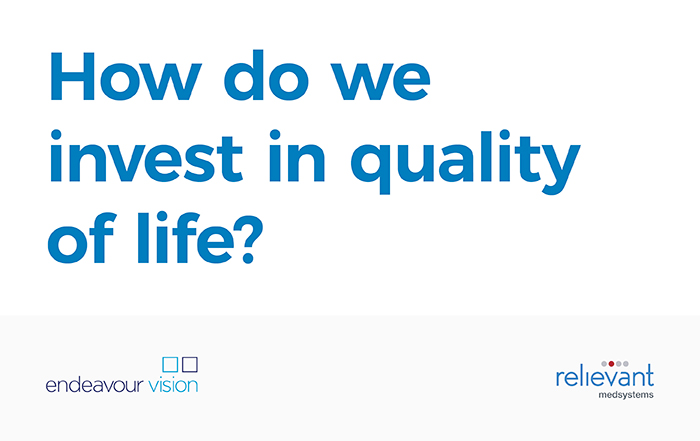
Quality of life (QoL) has long held various philosophical, political and health-related definitions. Yet while QoL has often been defined based on shifting societal norms and individual values – we can near-unanimously agree on the benefit of enjoying physical health free of chronic pain. In the last 40 years, carefully designed and validated instruments have been developed in medicine to measure health-related QoL in ways that include the physical, functional, social and emotional well-being of individual patients – as reported by patients. Despite tremendous advancement in this field, the subjective nature of QoL reporting (in particular as it relates to pain management) has challenged the medtech sector to find innovative solutions for QoL-enhancing therapies. Driving this momentum in the field of chronic low back pain (CLBP) is Relievant Medsystems, whose COO & Chief Medical Officer, Dr. Ray Baker and Vice President of Clinical Affairs, Diane Sahr, shared their insights on using QoL measures in clinical research.
What do we mean by health-related QoL?
Diane Sahr: QoL is a complex interplay between many different social, economic and health factors that affect the general well-being of an individual. It also encompasses one’s ability to perform the activities of daily living and be a productive member of society. For an individual, both physical and mental health are important factors of QoL.
Ray Baker: There are many ways of thinking about quality of life, which include, for example, the presence or absence of pain and physical function. In medicine, we’ve moved away from looking at QoL in an abstract way toward trying to quantify various factors that impact overall QoL.
How does overall QoL affect both individuals and societies?
Diane Sahr: Poor QoL presents an individual and collective financial burden (through work absenteeism, higher medical expenditures and disability costs) as well as an emotional burden on those experiencing it – which may also extend to loved ones and caretakers. As an individual experiences a decline in QoL, they often start to withdraw from social contact and isolate themselves.
Ray Baker: Chronic pain has a hugely detrimental effect on a person’s QoL, and commonly coincides with anxiety, depression and sleep disturbances, which may also limit physical and social functioning. Part of the battle is teasing these factors apart; as the more depressed a person is, the less likely they are to seek social interactions, and their QoL continues to decline. So, it is a vicious downward spiral.
What does QoL impact have to do with achieving the Sustainable Development Goals (SDGs)?
Diane Sahr: When we think about SDGs in relation to health, the WHO’s definition of health comes to mind ‘as a state of complete physical, mental and social well-being and not merely the absence of disease or infirmity.’ Measuring QoL for new therapies promotes both well-being and health in these terms. In addition, social determinants of health, which are conditions in the places where people live, work, or learn, affect a wide range of health and QoL risks and outcomes, which in turn impact the lives of working individuals. Therefore, improving QoL can, indirectly, help to promote economic development in a way that is conducive to improving the overall health of society.
How do we measure health-related QoL so that we can identify whether a medical intervention is actually helping people?
Diane Sahr: There are a few prominent measurements of QoL that have been validated across multiple chronic conditions and cultures. These questionnaires normally cover a core set of domains: pain, fatigue, physical functioning (i.e., climbing stairs, housework, running, sleeping), emotional distress (anxiety and depression) and social role participation. Some also assess a person’s ability to work.
What are the challenges and limitations in measuring QoL and how do we overcome them?
Diane Sahr: QoL survey responses reflect how the patient feels on that day and can be affected by many factors. For instance, the recent act of walking across a car park may change the way a patient answers a questionnaire about fatigue. We overcome this variability by asking people to answer questions about how they have been during the past seven days, and we collect responses over multiple timepoints. Also, it can be difficult to isolate the QoL impact of an individual therapy. It’s not just the therapy you are measuring, but everything that is going on with the patient. We have to look at large groups of patients to examine a data set that can indicate overall trends. We also want to use QoL measures to direct an individual’s care or treatment decisions. In that sense, one of the ultimate goals of the treatment model is to be more patient-centric and adjusted to specifically reported QoL measures that affect their daily lives.
Are health-related QoL measures used in everyday patient care and healthcare decision-making?
Diane Sahr: While QOL measurements are often performed in clinical research, the interpretation and use of these in directing patient care is less consistent. We need to do better in understanding how to use QoL data to implement treatment decisions and then train clinicians in how to do this effectively.
Ray Baker: I agree, what we do in research doesn’t yet translate to day-to-day clinical practice. Although QoL measures are often used by researchers and payers for reimbursement, we need to show that there is a benefit for patients to complete QoL surveys.
Diane Sahr: I think there will be a change in how we assess physical function through the use of more advanced medical technology, for example, by patients wearing electronic devices that measure distance moved or sleep quality. It will make some QoL measures much more objective, allowing for new opportunities in data-driven medtech solutions to improve QoL.
Can you tell us more about the impact of chronic pain on QoL?
Diane Sahr: There are numerous, multidimensional physiological and neurological contributors to the experience of pain. Additionally, measurements of pain have ‘floor and ceiling effects’ whereby it is difficult to assess an objective degree of pain an individual is experiencing, particularly in the case of severe pain. Chronic pain impacts every facet of an individual’s life. CLBP alone impacts nearly 557 million individuals globally (Global Burden of Disease Study 2017). In the U.S., CLBP’s direct costs are estimated at $90 billion annually. The indirect costs (e.g., productivity losses) are estimated to be as much or maybe even greater than the direct costs of inpatient and outpatient healthcare, so this is a very large global problem. Treatment success towards improved QoL needs to show both a reduction in pain and an associated improvement in function.
How does Relievant’s Intracept procedure improve QoL and patient well-being?
Ray Baker: The Intracept procedure reduces pain by deadening the nerves that transmit the pain from the vertebral endplate in the spine to the brain. And by doing that, we remove the pain response that was attached to the physiological problem causing it.
Diane Sahr: We see some patients reporting improvement in their pain and function within the first two weeks of receiving the Intracept Procedure. Within three months of the procedure, greater than 75 percent of people report significant improvements in function and pain. These are patients that on average have been suffering with CLBP for more than five years and many are experiencing degrees of depression as well. We are excited to have published our five-year outcomes, where two-thirds of the patients continued to report >50 percent reduction in their pain and nearly one-third were pain free at a mean of 6.4 years post-Intracept.
Ray Baker: This is a great example of the impact that health technologies can have on people and society, and we are proud to share that, since becoming FDA-cleared and commercially available in 2018 in the US, Relievant’s Intracept procedure has helped nearly 2,000 patients in the U.S. who were living with chronic pain. By raising awareness about the importance of reliably measuring QoL in the design and clinical application of biomedical interventions, patients, researchers and clinicians can act together to create sustainable, patient-centric care and treatment models that take patients’ everyday well-being into account.





